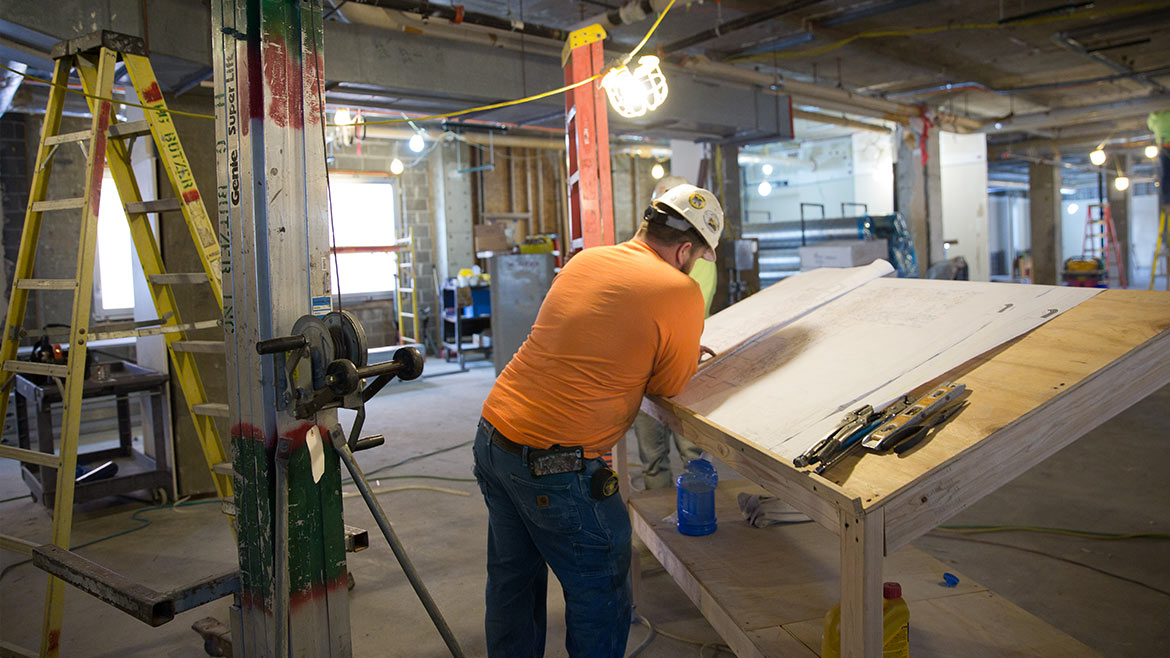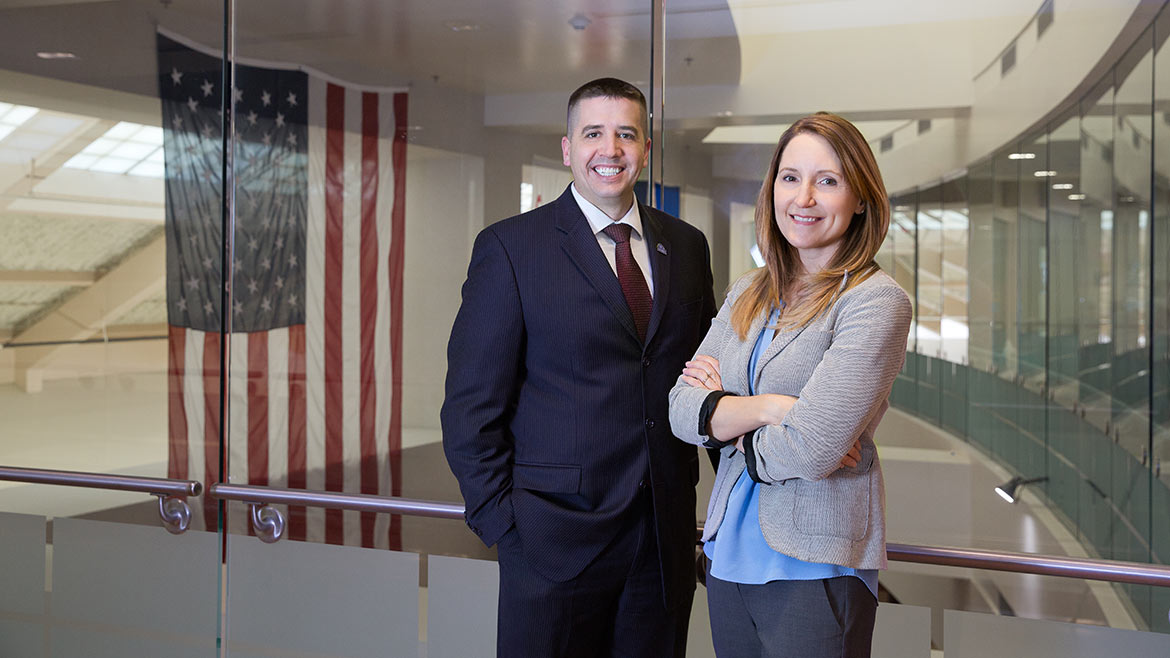
Harry S Truman Memorial Veterans’ Hospital completes major construction projects in a changing
political climate.
In his 39 1/2 years at Truman Memorial Veterans’ Hospital, Stephen Gaither has seen a lot of change, but nothing quite at the pace that has transformed the facility during the past decade.
Driving down Stadium Boulevard today, you can see that the level of activity has not relented. The large yellow crane tucked into the middle of the facility moves with the precision of a ticking clock. The chutes sticking out windows take away old materials and make way for renovations on the inside. The front entrance wears a tarp like a Band-Aid. The impression of a new parking garage can be imagined in the shadow of its $9.4 million predecessor.
“I like to joke that you almost need to wear a hard hat when you’re around here,” Gaither says. “For the past 10 years, it’s been one big project after another to enhance our infrastructure and increase our space.”
Gaither, the public affairs officer for the hospital, can rattle off the history of Truman VA with encyclopedic accuracy. But, even for him, keeping track of the list of current construction projects can be a bit more difficult. Gaither consults a PowerPoint presentation he shares frequently at town hall meetings in the hospital’s 43-county footprint across the state. The list highlights eight projects, including a handful of the ones scheduled to be completed in 2017, among which are the new dental clinic, the new patient education center, and the relocation of the intensive care unit.
Clay Atherton, chief of facilities management service, estimates that $30 million to $35 million in construction is currently underway. A lot of the improvements across the 19-acre facility (originally completed in 1972 for $15 million) are designed to meet current standards and ensure that the ever-increasing number of veterans gets the best care possible. Since the late 1990s, the number of veterans receiving care at Truman VA has grown from 15,000 to more than 38,000.
“We’re here to solve problems and take on challenges, and, for me and engineering staff, it’s fun,” says Atherton, 45, who has worked at the hospital for eight years. “No matter how careful you are, there is an impact on patients because it’s noisy and creates inconveniences. But when we finish a project and get positive feedback, it validates what we do.”
Thinking Inside the Box
The extent of the planning and construction carrying Truman VA forward are part of what drew David Isaacks back to the Midwest from sunny St. Petersburg, Florida.
After a year working as chief operating officer for the VA Sunshine Healthcare Network, he arrived in July 2016 to take over as medical director at Truman VA. For the 37-year-old, the move was a return to the VA Heartland Network, where he had spent nearly a decade working in the Kansas City and Topeka areas.
Isaacks had always looked at Truman VA as a model facility in the region. He appreciated the medical center’s strong relationship with MU, its robust research program, the longevity of the core leadership team, and its recognition as the sixth best place to work in the VA health care system, according to national surveys of all VA employees. The commitment to master planning supplemented these qualities.

“I was excited about this opportunity,” Isaacks says. “Coming somewhere new and pursuing my first permanent position as a medical director — a lot of those things weigh as very stable things, especially in an industry that can often be unstable and has a lot of risk associated with it.”
VA facilities nationwide are undergoing similar transformations to improve outdated infrastructures. Gaither says this emphasis started late in President George W. Bush’s tenure and increased under the Obama administration, especially with the scrutiny cast upon the Veterans Health Administration in 2014 following a series of scandals related to negligence in veterans’ medical care. Total VA funding has grown by nearly 86 percent since 2009, according to President Obama’s 2017 VA budget request.
But the political environment can always create volatility. At Truman VA, about 90 percent of the operating budget comes from congressional allocations (the rest comes from third-party reimbursements). Every project undergoes a different approval process, with the major construction projects requiring congressional approval. In some cases, the laws, which set limits on expenditures, haven’t kept up with increasing construction costs.
“A lot of times in the VA, we have to think inside the box because we have constraints,” Isaacks says. “Our facility management team is the best I’ve ever seen.”
The VA Heartland Network is the funding agent for Truman VA and other facilities in the region, taking money from the government’s allocation and distributing it to facilities. If there’s money available that another Heartland facility can’t use for construction, Truman VA can step in and say, “We’ve got a project you can fund.”
Since it can be difficult to know when money will become available and how much, the engineers at Truman VA have to be proactive at keeping improvement projects on the shelf and ready to go.
“Whatever the rule or regulation is, or even if there are unknowns, we try to work through that,” Atherton says. “Our commitment is to getting the work done.”
What will happen to VA funding over the next four years is unknown. It’s unclear if funds will be trimmed back or if the voices calling for a major shift in VA administration — such as privatization — will get louder. Whatever happens, Isaacks is focused; he’s confident his dedicated engineering staff will keep the hospital on top of its expansion and renovation goals.
For 2017, this means checking a few projects off his list and sending four to six more out for bids to contractors. The dental clinic and patient education center were completed in January, while the ICU relocation and inpatient surgery unit are on track to finish in the following months. The projects currently out for bids include a second parking garage on Monk Drive and the third phase of the ambulatory care addition.
“You get here and there’s a ton of construction — some of it is a headache for visitors, but we are still on track with our plans for this facility,” Isaacks says.
Making it Personal
Brick and mortar only tells part of the story at Truman VA. When Cheryl Hemme, 57, the chief of behavioral health services, walks around the second floor, she can’t help but glance at the posters sharing wall space with framed pictures of landmarks around Columbia.
These “Portraits of Recovery,” as they’re known at the hospital, highlight individuals who have overcome hardships through services at Truman VA. What’s particularly impactful are the quotes from each patient, revealing small details of their journey and offering encouragement to those who come after them.
“The heart of this hospital is truly veterans-first,” Hemme says.
Expanding the ICU from 12 to 14 beds accommodates increased inpatient activity. Moving the inpatient surgery unit, now on the sixth floor, to the third floor, adjacent to ICU, means patients will have single rooms with adequate sizing and amenities during their stay. Placing the ICU directly above the operating room suites, with a dedicated, properly sized elevator, means that veterans will no longer have to be transported down a common hallway after surgery to an elevator that takes them up five floors.

This focus on patients matters to Isaacks because he is one.
“I have a vested interest in making it better because I’m using it,” says Isaacks, who has leaned on the VA health care system since leaving U.S. Marine Corps in 2005.
Another point of emphasis for Isaacks in 2017 is improving patient safety. Truman VA is the only pilot site in the VA for the Hospital of the Future and High Reliability Organization Project. This three-year initiative, modeled after similar projects in the aviation industry, aims to solve health care’s most critical safety and quality problems.
“[Issacks] has pushed us to find ways to improve our care and efficiency, even if it means taking a risk,” says Dr. Lana Zerrer, 44, the chief of staff at Truman VA. “He is a huge advocate for veterans.”
Employees are engaged in the process and are helping facilitate many of the changes. Zerrer appreciates their readiness and their input on improving work areas and patient care. One recent example came from the hospital’s medical clerks, who requested a second computer monitor at their work stations to help with workflow management and scheduling processes.
“We’re listening to our employees and giving them the tools to do a good job,” Zerrer says. “The more empowered our employees feel, the happier they are. That leads to better productivity, better retention, and a better product — which is customer care.”
Although the salaries of VA physicians don’t always rise to the level of certain specialists in the private sector, the current enhancements are intended to create opportunities for Truman VA to recruit more health care professionals. The hospital hopes to see the current staff of 1,400 grow to 1,510 employees once all vacant positions are filled.
“When you have all the bells and whistles, it shows how committed you are,” Isaacks says. “And it brings in the best doctors, nurses, and administrative staff because they want to be proud of the care they can deliver.”
Looking into the Future
Every week, when Zerrer takes time away from administrative duties to be with her patients, she notices more children in the waiting rooms, and even more in her office during appointments. The hospital seems livelier.
“Things are a lot different now than they used to be,” Zerrer says. “It’s nice to hear kids laughing in the hospital. The VA has definitely changed, but the veterans are changing it more than us.”
Today, the VA system is more successful in reaching the youngest returning combat veterans than any other time in history. Since 9/11, almost 58 percent of those who served during Operation Iraqi Freedom, Operation Enduring Freedom, or Operation New Dawn have received VA health care services nationally.
Joshua Rudderforth, 35, is one of those veterans. He served with the Air Force from 2000 to 2008, including three tours in Iraq, before joining the Navy Reserve from 2009 to 2015. When he moved to Columbia last January, he decided to stop running from the dark residue of his military service.

“I knew I had a lot of issues that I wasn’t addressing,” says Rudderforth, whose PTSD contributed to volatile mood swings, terrible nightmares, and two divorces. “Pre-Iraq Josh was fun, but post-Iraq Josh was angry and couldn’t find his place in the world.”
The stigma related to mental health issues kept Rudderforth from going to visit a VA medical center. But once he found the Green Team, more formally known as the Behavioral Health Service Line, at Truman VA, things changed. He calmed down, learned to identify his emotions, and improved his relationship with his five kids. He even turned to Truman VA for his primary care.
“I didn’t realize all they offered,” Rudderforth says. “I thought the VA was only there to help veterans when they got really sick. It didn’t know it was such an all-encompassing health facility.”
Zerrer feels a special bond with veterans like Rudderforth, having been stationed in Kyrgyzstan in 2004 as part of her service with the U.S. Air Force.
“I served with that group and saw them come in and out of war,” Zerrer says. “So when they come into the VA, I feel a deep connection with them.”
Women are also reshaping the VA health care system, since they are serving in the U.S. Armed Forces more than ever. Truman VA has about 2,700 women enrolled, 51 percent of whom are between the ages of 21 and 49.
In the counties Truman VA serves, 33 percent of the eligible female veterans are enrolled to receive care, compared to 40 percent of males. Cindy Stivers, the Women Veterans Program Manager, helps ensure that women across Missouri are aware of services they can receive, including primary care, mammograms, cancer screenings, and more.
She enjoys telling the story of Helen Grahl, a Columbia resident who enrolled for health care services at Truman VA at 90 years old. Grahl served in Marine Corps Women’s Reserves in WWII, but didn’t consider herself a veteran and didn’t realize she was eligible to use the VA hospital. Even Stivers, who was in the Marine Corps from 1990 to 1994, waited almost 20 years before turning to the VA health care system.
“A lot of women veterans don’t realize the whole scope of all the different services we offer, which is a vast amount,” Stivers says.
Zerrer is excited about the future of Truman VA, and not just because of the fancy renovations and modern expansions, but because the foundation that’s been there all along provides the best opportunity to reach more veterans.
“We always strive to do what’s best for the veteran,” Zerrer says. “I see our employees do that every single day. They’re in trenches, dealing with that one veteran, trying to make their life better.”


